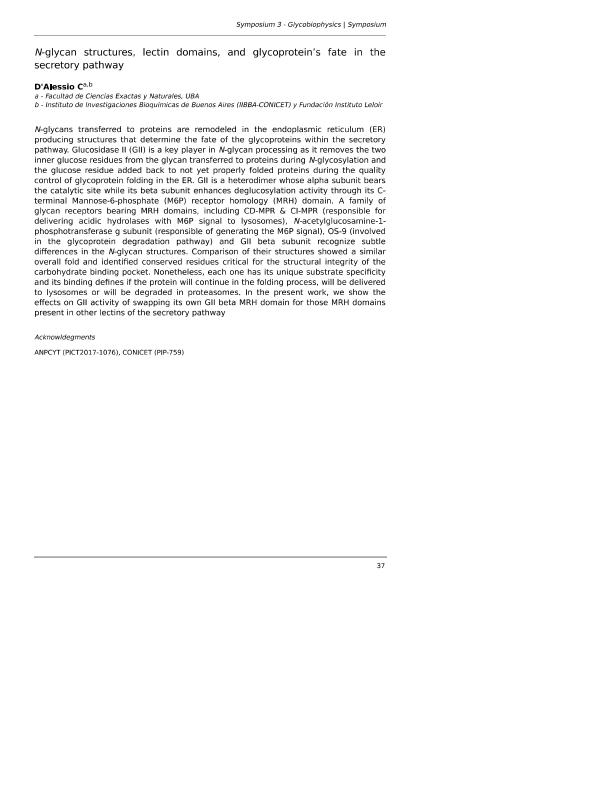Evento
N-glycan structures, lectin domains, and glycoprotein’s fate in the secretory pathway
Colaboradores:
Andujar, Sebastian Antonio

Tipo del evento:
Reunión
Nombre del evento:
XLVIII Reunión Anual de la Sociedad Argentina de Biofísica
Fecha del evento:
27/11/2019
Institución Organizadora:
Sociedad Argentina de Biofísica;
Universidad Nacional de San Luis;
Título del Libro:
XLVIII Reunión Anual de la Sociedad Argentina de Biofísica: Libro de resúmenes
Título de la revista:
Acta de congreso de XLVIII Reunión Anual de la SAB
Editorial:
Sociedad Argentina de Biofísica
ISBN:
978-987-27591-7-9
Idioma:
Español
Clasificación temática:
Resumen
N-glycans transferred to proteins are remodeled in the endoplasmic reticulum (ER) producing structures that determine the fate of the glycoproteins within the secretory pathway. Glucosidase II (GII) is a key player in N-glycan processing as it removes the two inner glucose residues from the glycan transferred to proteins during N-glycosylation and the glucose residue added back to not yet properly folded proteins during the quality control of glycoprotein folding in the ER. GII is a heterodimer whose alpha subunit bears the catalytic site while its beta subunit enhances deglucosylation activity through its Cterminal Mannose-6-phosphate (M6P) receptor homology (MRH) domain. A family of glycan receptors bearing MRH domains, including CD-MPR & CI-MPR (responsible for delivering acidic hydrolases with M6P signal to lysosomes), N-acetylglucosamine-1- phosphotransferase g subunit (responsible of generating the M6P signal), OS-9 (involved in the glycoprotein degradation pathway) and GII beta subunit recognize subtle differences in the N-glycan structures. Comparison of their structures showed a similar overall fold and identified conserved residues critical for the structural integrity of the carbohydrate binding pocket. Nonetheless, each one has its unique substrate specificity and its binding defines if the protein will continue in the folding process, will be delivered to lysosomes or will be degraded in proteasomes. In the present work, we show the
effects on GII activity of swapping its own GII beta MRH domain for those MRH domains present in other lectins of the secretory pathway.
Palabras clave:
Glycosylation
,
MRH domain
,
secretory pathway
,
yeast
Archivos asociados
Licencia
Identificadores
Colecciones
Eventos(IIBBA)
Eventos de INST.DE INVEST.BIOQUIMICAS DE BS.AS(I)
Eventos de INST.DE INVEST.BIOQUIMICAS DE BS.AS(I)
Eventos(OCA CIUDAD UNIVERSITARIA)
Eventos de OFICINA DE COORDINACION ADMINISTRATIVA CIUDAD UNIVERSITARIA
Eventos de OFICINA DE COORDINACION ADMINISTRATIVA CIUDAD UNIVERSITARIA
Citación
N-glycan structures, lectin domains, and glycoprotein’s fate in the secretory pathway; XLVIII Reunión Anual de la Sociedad Argentina de Biofísica; San Luis; Argentina; 2019; 1-1
Compartir



